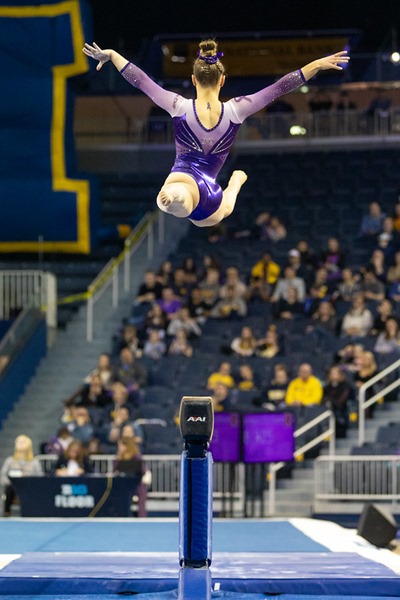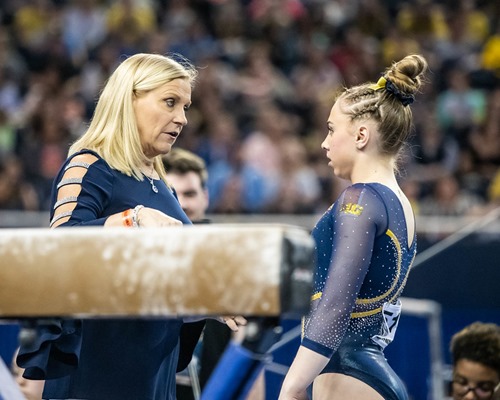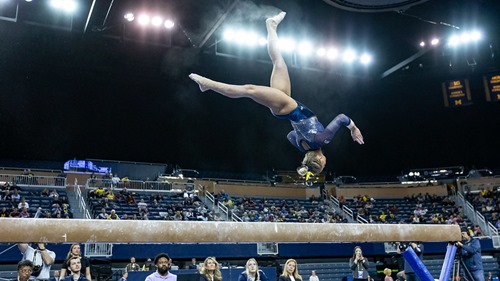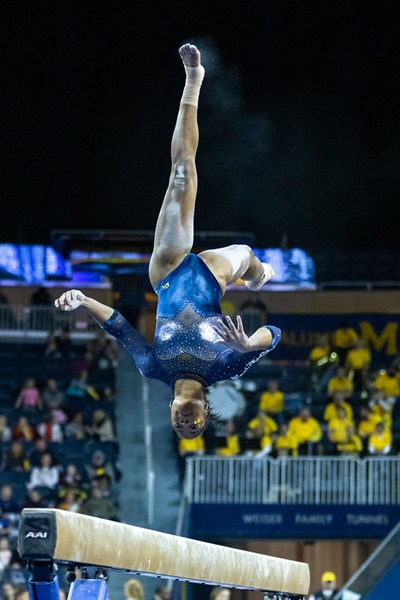
Steel

I want you to try something.
Extend your arm out until your elbow is straight, and hold your thumb and index finger about four inches apart. That’s a little wider than a credit card. A little less than half the width of a piece of notebook paper. Got it? Cool.
Now read this.

Now look back at your fingers.
Now imagine building up to his moment for fifteen years. The thousands of practice routines. The injuries. The gigantic bruises. The unimaginably large blisters (referred to quaintly as “rips,” but which, man, you do not want to Google Image Search that) that every bar worker suffers. The frustration of learning new skills, each of which seems physically impossible until it is mastered, at which time your reward is trying to add another half-twist. The pain and heartbreak of the uncountable falls that inevitably accompany a sport seemingly designed by someone unfamiliar with the normal mechanics of the human body.
Now imagine training for a year during COVID. Learning to practice with a mask on. Being isolated from your family. Getting tested six times a week in both nostrils until your nose bleeds. Staying away from normal college activities for fear that you could end your entire team’s season at any time by being in the wrong place at the wrong time. Enduring two weeks away from the gym mid-season in a sport built on consistency and repeatability. Surviving and advancing through NCAA Regional semifinals. And Regional finals. And National semifinals. And the first three rotations of National finals, on national television with a record audience watching.

JD Scott
The NCAA women’s gymnastics tournament consists of 1,632 routines. 1,631 were in the books.
One routine was left.
[Hit THE JUMP]
With the possible exceptions of Softball and Men’s Swimming and Diving, Women’s Gymnastics has been arguably the most successful athletic program at Michigan over the past three decades. Michigan has won 24 of the last 30 Big Ten championships. Head Coach Bev Plocki has more Big Ten titles than any coach, at any school, in any sport, ever. They’ve made 25 NCAA Championship appearances, 12 Super Sixes*, and one Four on the Floor* appearance during that time.
Fifty-two Michigan gymnasts have won a combined 199 All-American honors under Plocki, including 14 this year. Five Wolverines have won 9 individual NCAA champions, including All-Around titles by former Olympic Captain Elise Ray in 2001 and Kylee Botterman in 2011.

Dianna Oatridge
Plocki was National Coach of the Year in 1994, and has 11 Big Ten Coach of the Year and 11 Regional Coach of the Year awards to her name. Associate Head Coach Scott Sherman, who has been in Ann Arbor for 25 seasons, was the 2008 National Assistant Coach of the Year and has earned 7 Regional Coach of the Year honors. The rafters at the Donald R. Shepherd Gymnastic Training Center, not even 20 years old, are already running out of room.
They had won absolutely everything there was to win, and conquered all there was to conquer. Except this.
* The NCAA recently changed the format for the women’s gymnastics championships, which used to feature twelve teams in the championship semi-finals and six in the finals. Six teams on four events meant two bye rotations, which was both drawn out and clunky. The current format is inarguably better and more exciting. Also, “Four on the Floor” is a cooler name. Well done all around.
Gymnastics is a hard sport for a lot of us to understand.
That isn’t because it is particularly complicated. The rules of college gymnastics are pretty straightforward: a gymnast performs a routine. Different skills have different difficulties, and different errors when performing those skills have different deductions. Judges subtract those deductions from the value of the routine and post a score. High and low judges are thrown out, and the rest are averaged to give a score for that routine. Each team performs six routines on each event. The low score is dropped, the rest are totaled. 50 possible points on each event x 4 events = 200 possible points. High score wins.
No, it’s hard to understand because it is so far from anything that normal people can do, or have ever done. Most of us have shot a basketball or swung a baseball bat. A lot of us played high school sports. We’ve played pickup games and beer league softball. So even if we know we aren’t Steph Curry or Denard Robinson, we can understand what the players are doing. It is worlds apart from our experiences with those sports, but we recognize it. We can relate to it.
When it comes to gymnastics, most of us have never advanced beyond somersaults and cartwheels. We simply can’t comprehend what these athletes are doing. We can’t instinctively separate the good from the great, or the great from the other-worldly. Is a whip-double Arabian tumbling pass better than a three-and-a-half twist to a punch front? On vault, should we be more impressed by the Yurchenko one-and-a-half with a little hop on the landing or a slightly under-rotated front one-and-a-half? I’ve been watching competitive gymnastics for nearly 30 years, and often the best I can muster is “goddang that looked cool.”

JD Scott
But beam? We all understand beam, at least on some level. Because we have all tried – and failed – to walk across something narrow. At best, we look like Karl Wallenda trying to span some great chasm: arms outstretched, eyes glued downward, very carefully placing one foot in front of the other. The beam makes its mistakes clear to even casual viewers. Athletes wobble. They lose their balance. They fall. There is no hiding those errors.
The average adult female foot is approximately 3.5 inches wide. The balance beam is 4 inches wide. The margin for error is pretty easy to understand.
Even among gymnasts, the beam is different. And no one – no one – wants to end a close competition on beam.
In most years, what Michigan had done would have been enough already. They were sitting on a team score of 198.075, which would have been the third highest score in program history. It would have been a winning score in all but four NCAA finals since 1990.
They led after the first rotation with a 49.625 on floor after registering five scores of 9.9125 or better. They actually exceeded that on vault with a 49.650 that included two 9.975’s, one each from Abby Heiskell and Sierra Brooks. Then they posted another huge bar score with a 49.4875.
Those are massive scores. They are highlight-of-the-meet scores for your average Saturday in January. The kind of scores that put most opponents away well before the final rotation. But on this Saturday, all it bought them was a lead of 0.1375 over Oklahoma and 0.1625 over Utah. The two just kept coming. They were like elite marathoners a stride back of the leader; not winning, and not even closing ground, but far from losing. They kept pace, waiting for any sign of weakness. Any stumble. Any moment of doubt.
Waiting for Michigan to blink.
JD Scott
And halfway through the beam rotation, it looked like Michigan had blinked. Coming into the event, Michigan hadn’t count anything lower than a 9.8625. But after Carly Bauman led off with a 9.85, Gabby Wilson posted a 9.75. An arm wave on her flight series. A little balance check on her quarter-turn leap. Lauren Farley followed it up with a 9.7625. A little wobble on an aerial. A little off on the dismount. That was it. Two perfectly fine routines with a perfectly decent score at a time when “fine” and “decent” were not enough.
The math wasn’t complicated, though the task was overwhelming. Michigan needed to nail its last three beam routines. Not hit them. Nail them. They had to be as close to perfect as the strictures of gymnastics allow. Sixty seconds on the beam. No mistakes. Three times. Four inches.
Women’s gymnastics is a sport of haves and have-nots. In the 38 seasons since the NCAA started handing out hardware, only 6 teams had ever hoisted the trophy. Georgia had done it ten times. Utah, nine. UCLA, seven. Alabama, six. Oklahoma, four. Florida, three. The rest of the college gymnastics world combined: zero.
Michigan had been close before. They finished second in 1995, losing to Utah by 0.225 points. They finished second in 1999, losing to Georgia by 0.300 points. They finished third in 2001, losing to UCLA by 0.300 points. But while they have continued their dominance of the Big Ten over the last decade, they had slipped, ever so slightly, in the national picture. Despite reaching Nationals almost every season since 1995, Michigan hadn’t reached the finals since 2011, and they had missed Nationals altogether in 2016 and 2018.
But as this season progressed, it hinted at the possibility of something special. Other than an ankle injury to junior Abby Brenner in February, Michigan stayed relatively healthy. They stayed COVID-free. And they started posting huge scores. They set a program record on March 7 with a score of 198.025, a mark that lasted all of five days until they broke it again with a 198.100 the following week. They won the NCAA Regional semifinal. They won the NCAA Regional final with another 198.100. And they won the NCAA Championship semi-final for the first time ever, leading wire-to-wire with the best score they had ever posted in any NCAA championship competition.
It started to seem possible.
The Code of Points is the scoring system for college gymnastics. It tells judges what to look for and how much to deduct for errors. You take a hop on a landing? That’s a one-tenth deduction. Touch your hand to the beam to keep from falling? Three-tenths. Fall off? That’s half a point.
By the time Sierra Brooks mounted the beam for Michigan’s fourth routine, Michigan was already guaranteed to count 0.3875 worth of deductions. They could absorb, perhaps, two more tenths between their final three routines. Maybe three tenths if Oklahoma stumbled a bit, though that seemed unlikely. To call Michigan an underdog at that moment would be generous.
But then Sierra Brooks did this:
And Natalie Wojcik, the reigning NCAA beam champion, did this:
A 9.9625 and a 9.9875. I’ve watched those routines over and over, and I still can’t spot the deductions. But in my defense, at least some of the judges agreed with me, with two of the six giving Brooks a perfect 10.0 and four judges doing the same for Wojcik.
Abby Heiskell had no way to know this, but when she began her routine, Michigan trailed Oklahoma by .0875. It was the first time Michigan had trailed all day. It was the first time Michigan had trailed since the second rotation of the Regional semifinal. After being a frontrunner for two weeks, Michigan couldn’t hold on. They had to take it back. But it was there to be taken.
And then… this.
Most Michigan fans probably won’t remember these three routines the way they remember Trey Burke’s shot against Kansas or Charles Woodson’s Ohio State heroics or the Mike Legg goal. At least not with the same specificity. Such is the fate of non-revenue sports. These athletes spend decades building to a moment, and we merely join them there, curious outsiders to the impossibly complicated and challenging world they inhabit.
We stay for a few weeks, or a few days, or even a few hours. We cheer. We emotionally invest ourselves. We learn, mid-stream, the nuances and the rules and the personalities and the backstories. And when it is over, we put those specifics away. We blend them together, and place them in a jar on the shelf carrying a generic label like “2019 Michigan Baseball” or “2015 Michigan Softball.” We occasionally open the lid and recall the feelings, but we forget many of the specifics.
Don’t let that happen here. Don’t allow yourself to forget the absolute steel in the spines of these three women to accomplish these three very specific tasks. All three had fantastic meets, posting career high all-around scores of 39.725 or better. And they were far from the only key contributors, either on Saturday or during the tournament run. Indeed, Michigan needed literally every tenth of every point from every routine. One more bobble, one step out of bounds, one short handstand, one hop on a landing, and Michigan leaves with a painful what-if.
But you can follow gymnastics for the rest of your life and not see anything more impressive than what Sierra Brooks, Natalie Wojcik, and Abby Heiskell did over that eight minute stretch. It should live in the annals of Michigan sports lore long after the confetti is swept up and the trophy finds a home on the shelf.
And the next time you feel like you are bearing the weight of the world on your shoulders, be grateful that you don’t have to do so on anything that narrow.
Best post I've read here in a very long time. Thanks for sharing and bumping.
and that's not a slight to Brian, Ace, Seth, et al
Yep!
April 22nd, 2021 at 11:25 AM ^
This post should be in the annals of MGOBLOG posts!
Could not agree more. I have a 9 year old daughter who is an aspiring gymnast that has watched the 2 hour long ESPN replay 6 times already. Magical.
April 23rd, 2021 at 10:00 PM ^
Hard sport to understand? You obviously don't have a daughter that does Cheerleading...
Amen. We needed this
You are right we did need this!!! I watched it live and was mesmerized by the drama! Go Blue! These women had "Blue Steel Ice" in their veins. I am a very proud alum! Also this was one of the best pieces I have ever read on this blog (and I read ALL of them)!!! Thank You BiSB
BiSB needs to respond to this post toward the top so he can get the posbang he richly deserves.
I'm here so I don't get fined.
This may be gauche to say on MGoBlog, but your writing had better be getting published in other outlets under your real name.
April 22nd, 2021 at 11:12 PM ^
I've actually got tears in my eyes, and I had no idea this was even happening until I saw this post. Phenomenal account of a phenomenal event.
April 22nd, 2021 at 10:58 PM ^
Could not agree more. Well done BiSB.
This team deserved a well written article on Mgoblog and BiSB, you nailed it.
What a great story and article. Well done to the team and BiSB!
Yah, in middle school, during gym the boys including me would slip off the bar and often get balls crushed.
This is "Eleven Swans" territory writing. Thank you for giving that event and this team its due.
Wow this was an exceptional article! I wasn’t able to watch and even though I knew the result this made me feel like I was watching live.
April 22nd, 2021 at 10:35 AM ^
Edit: Wrong person reply, my bad.
April 22nd, 2021 at 10:36 AM ^
Thanks for intriguing me enough to track that post down Ccapilla!
EDIT: OK, something's broken.
Agree - we are fortunate to have some excellent writers on "this here footbah blog". Amazing write up; once of (if not the) best articles I've read here.
I thought that the routine on the beam would have all the noise of a PGA putting green. Hearing her teammates screaming surprised me, but hearing them erupt when the stick their landing gave me goosebumps!
BiSB, I love the humor you bring, and Opponent Watch is my favorite part of the blog.
But THIS is the best piece of writing I've ever seen from you. Thank you!
Wow! Truly excellent article!
Well said!!
Great article....read it and realized I was feeling exactly as it was written when I watched it live last weekend.....good stuff and thank you!
That Heiskell routine. The wait.
I was gripped throughout.
April 22nd, 2021 at 12:30 PM ^
After her routine, after she grabbed her mask, she stopped and grabbed her chest, then a step later she did it again. A girl at work who wears her emotions on her sleeve claims that when she is real happy her heart hurts. When Abby stopped and clutched her chest like that, that's what I thought, 'She's so happy her heart hurts.'.
Damn....if that doesn't put a chill up your spine.....
GO BLUE
This. This is what collegiate sports is all about IMHO. Thanks for the great write up, and congratulations to these women who have represented our University at the highest level!
Congratulations to those women. They are champions and deserve a well written account of their brilliance. Great article and Go Blue
April 22nd, 2021 at 10:03 AM ^
Thanks for writing this! I was watching the replay prior to one of the NCAA volleyball tournament sessions, and even knowing how it was going to play out, I got chills. An amazing accomplishment for the women and for the program, and well deserved.
April 22nd, 2021 at 10:04 AM ^
Fantastic write-up and a most impressive performance. I only have a small window of the experience as my daughter did gymnastics for a handful of years. There was so much pressure after so many hours of practice and one slight wobble or mistake would end in disappointment. I can only imagine the pressure of that moment and the focus and discipline that it took to nail those routines. What a great moment for all of these athletes to deliver near perfection in such circumstances. Bravo.
April 22nd, 2021 at 10:05 AM ^
Wow. Amazing what the women did, amazing their talent, amazing their nerve.
A national championship of spine and skill, and amazing perseverance. Go, Blue!
And thank you, BisB, for doing such a terrific job putting their amazing accomplishment in context. A wonderful article.
April 22nd, 2021 at 10:10 AM ^
Fantastic write-up. Congrats to the National Champions.
April 22nd, 2021 at 10:10 AM ^
An apropos write-up for a first in school history. Congratulations laides, take a bow. Cheers BiSB.
April 22nd, 2021 at 10:10 AM ^
This was impressive. I don't follow gymnastics closely, but am old enough to remember some of the great moments from from the US Olympic team over the years. The perfection of these 3 beam routines are almost as impressive as the vault to finish with the team gold medal in the 96 Olympics.
April 22nd, 2021 at 10:14 AM ^
Excellent post. Almost as good as those young women performances.
April 22nd, 2021 at 10:16 AM ^
I'm old enough to remember Nadia Comaneci and her perfect 10's in the 1976 Olympics and how it was all the rage for months.
The achievements by the Michigan women gymnasts - both as a team and as individuals - exceeded that for drama, execution and as an inspiration to aspiring gymnasts.
April 22nd, 2021 at 10:20 AM ^
There is nothing so beautiful as the look on an athlete's face when they've nailed something really hard, and they know it.
Great post. Thanks.
April 22nd, 2021 at 10:21 AM ^
Great post! My wife and I were on pins and needles the whole time during that meet.
April 22nd, 2021 at 10:22 AM ^
very well said.
April 22nd, 2021 at 10:24 AM ^
Thank you BiSB for giving the UM Women's Gymnastics team such well-deserved front-page coverage. This goes down as one of the greatest UM sports stories of all time. Absolutely nuts that all three of these women executed near perfectly in serial with everything on the line. Brava!!
April 22nd, 2021 at 10:25 AM ^
Quality stuff, BiSB! Being a casual fan of gymnastics, I had no idea of the drama that took place this year and the pressure these young athletes faced and overcame. Thanks for the great story.
April 22nd, 2021 at 10:30 AM ^
This might be the best piece ever posted on here.
April 22nd, 2021 at 10:31 AM ^
Confession time: I'd half forgotten about the finals and was walking the doggies for most of the meet and it wasn't until I got back and idly checked here that I saw they were on ABC (no ESPN or BTN access here), and was able to catch the last 20 minutes when the title was in balance. So I didn't expect to be so caught up in the exhilaration of it all, but that's what made it personally such a rush.
The only other time I was as caught up in gymnastics was the famous 1996 Olympic match with Kerri Strug. And that was of course an iconic memory that the whole nation rejoiced in, but this one is just a little more special because it's a win that our often crazy Michigan-obsessed internet family gets to call its very own.
April 22nd, 2021 at 10:32 AM ^
Someone cutting onions in here...?
Well written, BiSB!
April 22nd, 2021 at 10:44 AM ^
Fantastic post! Bravo!
April 22nd, 2021 at 10:46 AM ^
phenomenal post, this is the quality of writing the keeps me coming back to read about MI sports.
Kudos to those women, herculian task.
April 22nd, 2021 at 10:51 AM ^
More congratulations to the athletes, more congratulations to BisB.
Though a bit off-topic, I thought some might enjoy a little historical background, that gymnastics emerged out of circus in the 1800s. Pommel horse and vault came directly from feats on and off the circus horse running around the ring. The bar routines—uneven, parallel & high—replicated trapeze moves. Still rings are still a circus act. Floor exercise is the same as general circus acrobatics.
Balance beam echoes high wire, not as dangerous BUT adding moves of greater difficulty. Incredible difficulty. Go, Blue!
P.S. If you want to walk on something narrow, do not look down at your feet but straight ahead.
(Another indirect connection to circus: in its earliest days, it wasn't called circus yet, the word reserved for the circular arenas. Among the many names tried was "Olympics," decades before the modern Olympics movement started in 1896.
April 22nd, 2021 at 11:03 AM ^
I, unabashedly, have immense pride in my school. But few moments have given me a rush of school pride as intense as while watching those final routines. The definition of finishing strong under intense pressure.
I will remember those last 3 routines -- in particular the beaming smiles as each stuck their respective dismounts -- as much as the Legg and Morrison goals, the Burke shot and Higgins put-back, and the Woodson interception. To have those final 3 routines immortalized with this article is a treasure. Thank you.

Comments